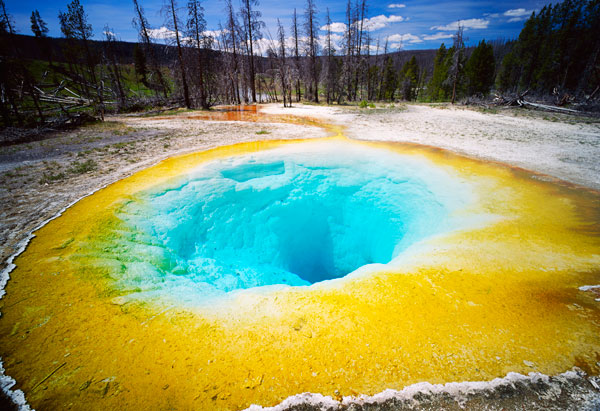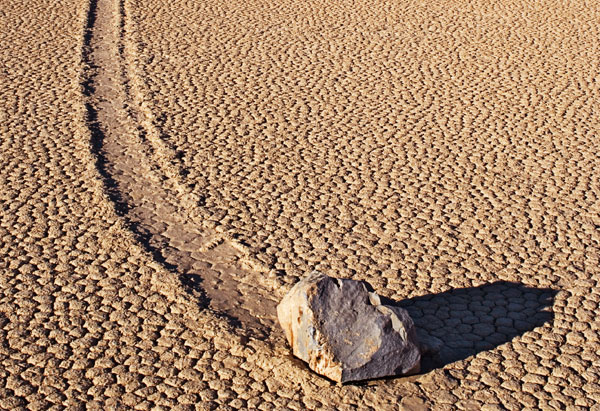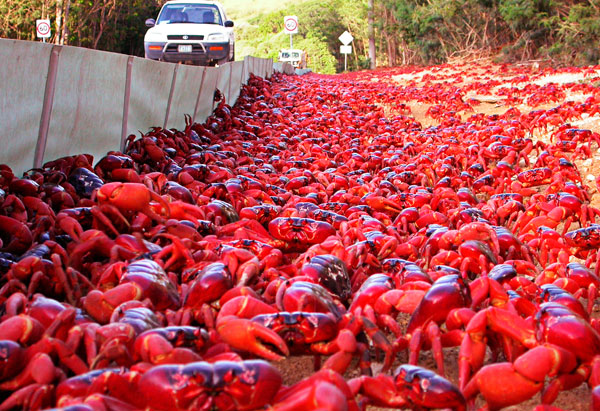
Photo: Lee Frost/Getty Images
Nothing blows the mind quite like the curiosities dreamed up by nature. O takes you to 10 awe-inspiring and absolutely humbling wonders of our world.
The Isle of Eigg
This little island (pictured above) a few miles off Scotland looks ordinary enough, with a rugged coastline similar to that of the other 40 or so isles that surround it. What makes Eigg unique is the music it produces. As you run your hands through the sand at the Bay of Laig, you may hear high-pitched notes, like the sounds of some otherworldly string section warming up. The sand grains are pure quartz, highly rounded and of fairly equal size. In dry conditions, they can rub against each other in a way that produces instrument-like vibrations, resulting in the beach's mysterious song. —Arianna Davis
The Plitvice Lakes
Deep in the woodlands of Croatia's Dinaric Mountains is an enchanting valley populated by deer, wild boar, wolves, bears, and some 126 species of birds. But the valley's gems are tucked in its limestone bottom: 16 terraced lakes that cascade into one another, spilling over mossy ledges and plunging down canyon walls. (One thundering waterfall drops 230 feet.) Depending on sunlight and the season, and the mineral composition of the bedrock, the colors of the lakes shift from azure to green to gray. Visitors to this misty, fluid landscape can wander down wooden walkways that offer meditative views of flower-filled meadows, caves, crags, and pools clear enough to catch the eye of a fish. —Kristy Davis
Next: The most beautiful pool of bacteria you've ever seen (really)

Photo: Jeff Foott/Getty Images
Morning Glory Pool
In Yellowstone National Park, there is a hot spring (pictured above) that's alive (literally!) with electric hues. Named for its likeness to the azure, funnel-shaped morning glory flower, the pool gets its color from the bright blue bacteria that thrive in its scalding temperatures. The water averages 171.6 degrees, but it used to be even hotter—closer to 200 degrees—and bluer. Early visitors to the park tossed in coins and other objects, clogging the spring's geothermal source and allowing other, cooler-temperature yellow and orange microbes to spread further and further into its 23-foot depth. But there is hope the spring will one day return to its sapphire splendor: Back in 1950 it erupted like a geyser, ejecting, among other debris, $86.27 in pennies and 76 handkerchiefs. A few more purges like that one just might do the trick. —Jessica Silvester
Tsingy de Bemaraha
Some 200 million years ago on the island of Madagascar, a plateau of pure limestone lay in wait. Then water had its way: Erosion erased stone, leaving behind a forest of mineral spires—or tsingy, which translates "where one cannot walk barefoot." Imagine a fortress of razor-sharp pinnacles that shave the sky, and ghost-white lemurs leaping from column to column. Down below, deep canyons unravel in an ethereal labyrinth. —Kristy Davis
The Ochtinsk Cave
In this Slovakian cave, delicate white crystals grow along the walls like creeping wildflowers. The spectacular displays—branching tree formations, spirals, and coral patterns—won the site a spot on the UNESCO World Heritage list. —Arianna Davis
Next: Hundred-pound rocks that move all by themselves
In Yellowstone National Park, there is a hot spring (pictured above) that's alive (literally!) with electric hues. Named for its likeness to the azure, funnel-shaped morning glory flower, the pool gets its color from the bright blue bacteria that thrive in its scalding temperatures. The water averages 171.6 degrees, but it used to be even hotter—closer to 200 degrees—and bluer. Early visitors to the park tossed in coins and other objects, clogging the spring's geothermal source and allowing other, cooler-temperature yellow and orange microbes to spread further and further into its 23-foot depth. But there is hope the spring will one day return to its sapphire splendor: Back in 1950 it erupted like a geyser, ejecting, among other debris, $86.27 in pennies and 76 handkerchiefs. A few more purges like that one just might do the trick. —Jessica Silvester
Tsingy de Bemaraha
Some 200 million years ago on the island of Madagascar, a plateau of pure limestone lay in wait. Then water had its way: Erosion erased stone, leaving behind a forest of mineral spires—or tsingy, which translates "where one cannot walk barefoot." Imagine a fortress of razor-sharp pinnacles that shave the sky, and ghost-white lemurs leaping from column to column. Down below, deep canyons unravel in an ethereal labyrinth. —Kristy Davis
The Ochtinsk Cave
In this Slovakian cave, delicate white crystals grow along the walls like creeping wildflowers. The spectacular displays—branching tree formations, spirals, and coral patterns—won the site a spot on the UNESCO World Heritage list. —Arianna Davis
Next: Hundred-pound rocks that move all by themselves

Photo: Dennis Flaherty/Getty Images
Death Valley's Sailing Stones
Imagine rocks weight up to several hundred pounds gliding from one spot to another, all by themselves. This has been known to happen in the middle of the Mojave Desert, on a sun-baked lake bed called Racetrack Playa. Although no one has ever actually seen the rocks in motion, we know they move because of the tracks they leave—sometimes straight paths, sometimes curved trails nearly 3,000 feet long. Researchers hypothesize that a precise recipe of elements is responsible: Melting snow from the surrounding mountains runs into the playa below, turning dry clay into slick mud. As temperatures plummet at night, a rim of ice forms around the base of the playa's rocks. As more water flows in, the ice floats the rocks ever so slightly. Then come the winds. Gusts of 50 miles per hour or more set the stones sailing. —Crystal Martin
The Morning Glory Cloud
The glider pilots who surf the Morning Glory call it "heavenly." Its technical description is "roll cloud"—an extremely rare atmospheric formation that flows backward as it moves forward, stretching as far as 600 miles across the horizon. Scientists don't entirely understand the physics behind the cloud's formation, but the conditions in Australia's Gulf of Carpentaria in September and October are perfect for summoning it: In the early evening, westerly breezes from the gulf and easterly ones from the Coral Sea collide over a peninsula, creating a tubular wave of air. Thanks to the area's high humidity, the moisture in the air condenses to form this breathtaking spectacle in the sky. —C.M.
The Underground Orchid
The more than 22,000 species of the orchid family are known for growing in exotic and hard-to-reach places. But Rhizanthella gardneri is one of the most elusive. It blooms in buried darkness. With no chlorophyll, the tiny plant seems to rely upon a symbiotic fungus that steals nutrients from nearby shrubs. In late May, the orchid's stem grows a head filled with up to 100 miniflowers, which draw insects like gnats and termites down into the soil for pollination. Today fewer than 50 of these plants are known to exist. —Jessica Sylvester
Next: An island that gets overtaken by crabs—every single year
Imagine rocks weight up to several hundred pounds gliding from one spot to another, all by themselves. This has been known to happen in the middle of the Mojave Desert, on a sun-baked lake bed called Racetrack Playa. Although no one has ever actually seen the rocks in motion, we know they move because of the tracks they leave—sometimes straight paths, sometimes curved trails nearly 3,000 feet long. Researchers hypothesize that a precise recipe of elements is responsible: Melting snow from the surrounding mountains runs into the playa below, turning dry clay into slick mud. As temperatures plummet at night, a rim of ice forms around the base of the playa's rocks. As more water flows in, the ice floats the rocks ever so slightly. Then come the winds. Gusts of 50 miles per hour or more set the stones sailing. —Crystal Martin
The Morning Glory Cloud
The glider pilots who surf the Morning Glory call it "heavenly." Its technical description is "roll cloud"—an extremely rare atmospheric formation that flows backward as it moves forward, stretching as far as 600 miles across the horizon. Scientists don't entirely understand the physics behind the cloud's formation, but the conditions in Australia's Gulf of Carpentaria in September and October are perfect for summoning it: In the early evening, westerly breezes from the gulf and easterly ones from the Coral Sea collide over a peninsula, creating a tubular wave of air. Thanks to the area's high humidity, the moisture in the air condenses to form this breathtaking spectacle in the sky. —C.M.
The Underground Orchid
The more than 22,000 species of the orchid family are known for growing in exotic and hard-to-reach places. But Rhizanthella gardneri is one of the most elusive. It blooms in buried darkness. With no chlorophyll, the tiny plant seems to rely upon a symbiotic fungus that steals nutrients from nearby shrubs. In late May, the orchid's stem grows a head filled with up to 100 miniflowers, which draw insects like gnats and termites down into the soil for pollination. Today fewer than 50 of these plants are known to exist. —Jessica Sylvester
Next: An island that gets overtaken by crabs—every single year

Photo: Courtesy of Christmas Island Tourism
The Annual Trek of the Christmas Island Crabs
For a few week a year, this tiny island in the Indian Ocean is literally crawling with crabs. Sometime between October and December, cued by seasonal rains and a waning moon, millions of the bright red critters emerge from their burrows in the rainforest floor and begin an epic trek to the coast (pictured above). Scurrying down cliff faces and creeping through towns, they can travel over four miles en masse: "Sometimes there are so many in one place, it looks like a sea of red," says island resident Linda Cash. "When the crabs cross the roads, locals are stopping traffic and scooping them out of harm's way." Once they reach the beach, the crabs mate and the females release their eggs into the surf, where the offspring will grow through the larval stages. One month later, the surviving babies—now just five millimeters long—will crawl onto shore and begin their journey inland, climbing 1,200 feet into the forest. —Catherine DiBenedetto
Subterranean Ant Cities
Just out of sight, beneath the surface of the ground in humid climes of North and South America, leaf-cutter ants are busy building megalopolises. In the construction of a single nest—a massive complex of corridors and chambers, garbage pits and fungal gardens—millions of ants may carry as many as 44 tons of soil aboveground, each load four times the weight of the insects themselves. The mature city can measure more than 700 square feet. Scientists refer to colonies like this as superorganisms because each worker is like a cell programmed to perform a specific task in an elegantly complicated system only Mother Nature could design. —C.D.
Stay in Awe
For a few week a year, this tiny island in the Indian Ocean is literally crawling with crabs. Sometime between October and December, cued by seasonal rains and a waning moon, millions of the bright red critters emerge from their burrows in the rainforest floor and begin an epic trek to the coast (pictured above). Scurrying down cliff faces and creeping through towns, they can travel over four miles en masse: "Sometimes there are so many in one place, it looks like a sea of red," says island resident Linda Cash. "When the crabs cross the roads, locals are stopping traffic and scooping them out of harm's way." Once they reach the beach, the crabs mate and the females release their eggs into the surf, where the offspring will grow through the larval stages. One month later, the surviving babies—now just five millimeters long—will crawl onto shore and begin their journey inland, climbing 1,200 feet into the forest. —Catherine DiBenedetto
Subterranean Ant Cities
Just out of sight, beneath the surface of the ground in humid climes of North and South America, leaf-cutter ants are busy building megalopolises. In the construction of a single nest—a massive complex of corridors and chambers, garbage pits and fungal gardens—millions of ants may carry as many as 44 tons of soil aboveground, each load four times the weight of the insects themselves. The mature city can measure more than 700 square feet. Scientists refer to colonies like this as superorganisms because each worker is like a cell programmed to perform a specific task in an elegantly complicated system only Mother Nature could design. —C.D.
Stay in Awe




